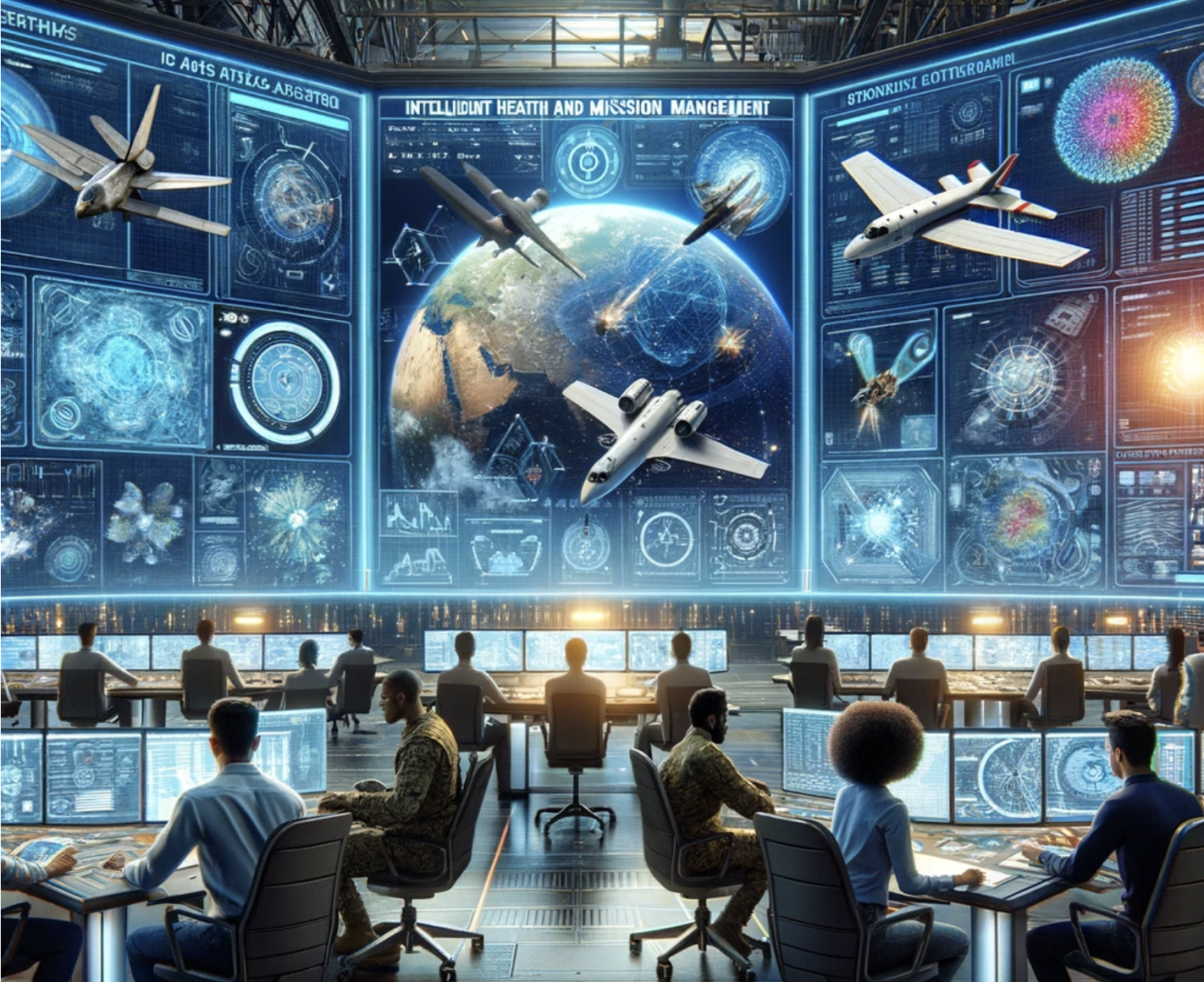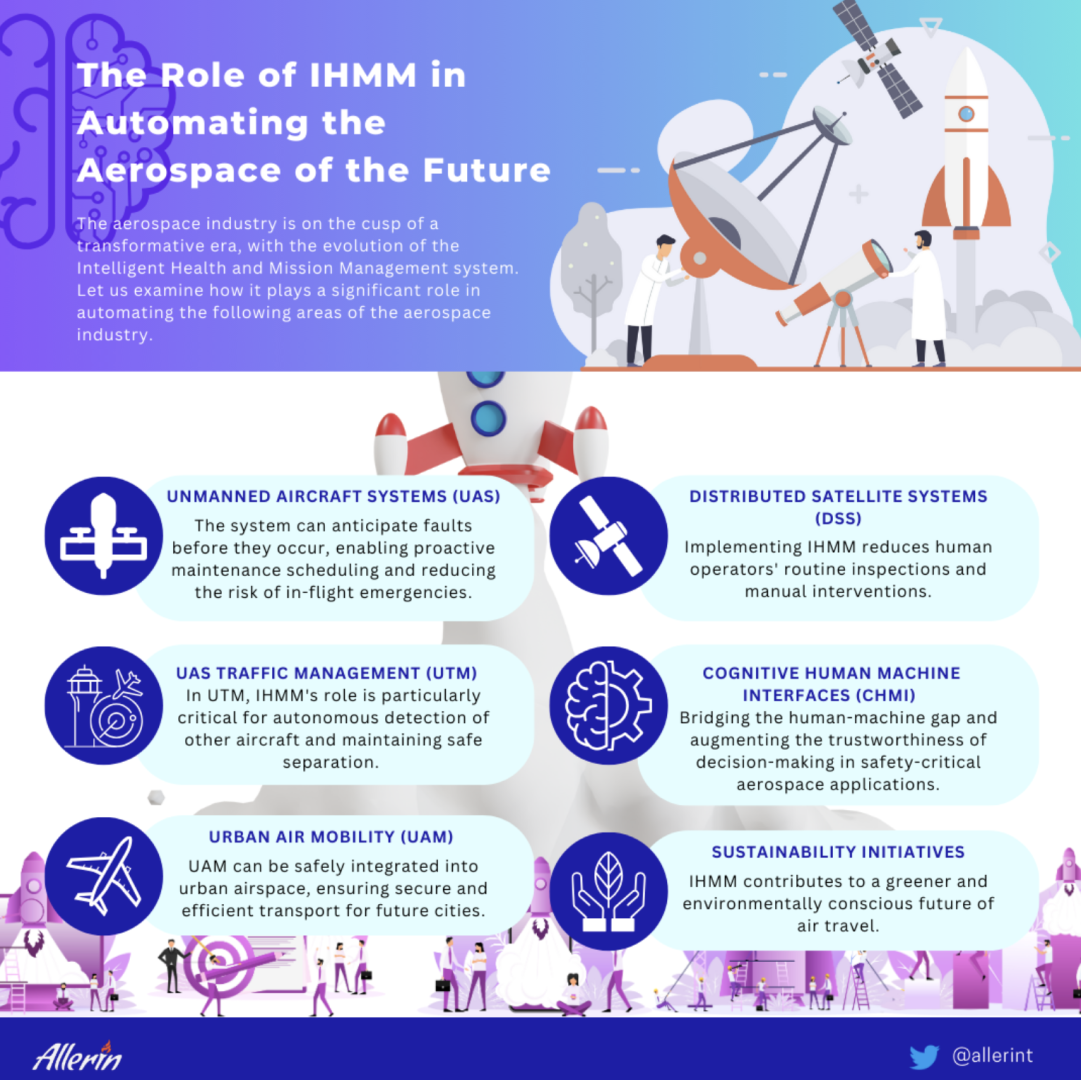Comments
- No comments found

The aerospace industry is on the cusp of a transformative era, with the evolution of the Intelligent Health and Mission Management system.
This next-generation technology must be integrated with AI-based diagnostic and prognostic models for a robust and comprehensive solution.
Originally, Structural Health Monitoring (SHM) was all about checking the safety of aerospace platforms by detecting deformations and damage early on. NASA expanded this idea with Vehicle Health Monitoring (VHM), using sensors and software to monitor various aspects of aerospace vehicles.
The development of data from monitoring to management gave rise to Integrated Vehicle Health Management (IVHM, where data became instrumental for maintaining and planning purposes. IVHM is integrated into the vehicle and its subsystems, bringing benefits like better decision-making and cost savings through Condition-Based Maintenance (CBM). The term Integrated System Health Management (ISHM) was coined to cover complex aerospace systems beyond just vehicles, breaking down systems into their elements and studying their interactions. The word "Intelligent" was added to Intelligent Integrated Systems Health Management (IISHM) to emphasize the integration of artificial intelligence (AI) to automate analysis and determine the health of all elements in the system. This technology is crucial for the future safety and efficiency of aerospace systems.
However, the current concepts of ISHM have limitations. One of the limitations includes monitoring and controlling functions on a subsystem level with relatively basic control laws. As a result, they are not deemed critical for safety or essential for mission success. The need to overcome these shortcomings led to the next significant advancement in this field, which is aptly called Intelligent Health and Mission Management (IHMM). IHMM aims to address these limitations by incorporating capabilities for real-time mission planning, tactical decision-making, and adjusting system configurations to compensate for potential failures. By combining health monitoring with mission management, IHMM seeks to create a more robust and adaptive approach to ensure the safety and success of critical missions.
Further, let us examine the IHMM and how it leads automation to develop a futuristic aerospace industry. Role of Intelligent Health and Mission Management in Automating Aerospace Industry. IHMM is an advanced aerospace technology that integrates cutting-edge sensors, artificial intelligence and data analytics to monitor, manage and optimize the health performance of an aircraft during missions. This innovative system is designed to enhance safety, efficiency and overall mission success in the aerospace industry. The primary objective of IHMM is to provide a comprehensive mission management solution that ensures continuous monitoring of systems conditions and real-time health assessment of all critical systems for missions. By predicting potential faults or performance degradation well in advance, IHMM allows timely corrective measures and system reconfiguration to maximize mission performance. In addition to the conventional benefits of health management, IHMM offers accurate and reliable real-time awareness of the system's state of health, considering mission, operational and environmental factors. This invaluable information leads to well-informed and adaptive decision-making, thereby enhancing safety, reliability and overall mission success probability.
A fully developed IHMM system possesses dynamic predictive capabilities, enabling it to anticipate functional performance degradation and pinpoint specific components or subsystems that require reconfiguration. This flexibility allows for proactive changes to the mission profile to restore optimal operational capability before the possibility of a failure event, mitigating the risk of accidents or mission aborts. The IHMM represents a significant step forward in the aerospace industry. Let us examine how it plays a significant role in automating the following areas of the aerospace industry.

IHMM plays a pivotal role in developing advanced unmanned aircraft systems. IIHM facilitates real-time monitoring and management of the aircraft's health and mission performance by combining sensor technology, AI algorithms, and data analytics. The IIHM system continuously collects data from various critical components, detecting wear, stress or failure signs. By leveraging predictive maintenance capabilities, the system can anticipate faults before they occur, enabling proactive maintenance scheduling and reducing the risk of in-flight emergencies.
Additionally, IIHM facilitates mission management automation, allowing for optimized flight operations and navigation. They consider environmental factors, airspace constraints and mission objectives to make autonomous decisions that enhance safety, efficiency and mission success. IIHM also paves the way for the widespread adoption of UAS in various applications, including urban air taxis, surveillance, delivery services and beyond.
In the fast-evolving aircraft industry, Intelligent Health and Mission Management (IHMM) systems are playing a transformative role in UAS Traffic Management (UTM). As Unmanned Aircraft Systems (UAS) usage increases, integrating them safely into existing airspace has become a major research and development focus. The UTM concept, a cooperative network seamlessly integrated with Air Traffic Management (ATM), facilitates the safe coordination of UAS operations.
UTM operates as a network-centric traffic management system, exchanging crucial flight and mission information among stakeholders. IHMM is a vital component in this framework, autonomously monitoring the health of UAS and generating important health information shared across the network. It enhances safety margins and supports greater situational awareness by ensuring the reliability of exchanged information.
In UTM, IHMM's role is particularly critical for autonomous detection of other aircraft and maintaining safe separation. As UAS encounters grow, IHMM's real-time monitoring and dynamic adjustments enable safe and efficient operations, making it a fundamental enabler of UAS Traffic Management's continued growth and success.
In addition to unmanned aircraft, the rise of on-demand Urban Air Mobility will significantly impact airspace management. Since UTM handles unmanned aircraft operations, UAM enables highly automated, cooperative passenger transport in urban and suburban areas. This concept is supported by advancements in Distributed Electric Propulsion (DEP) and Electric Vertical Take-Off and Landing (eVTOL) aircraft designed for operation within designated corridors. Unlike unmanned aircraft, UAM introduces higher public exposure to operational hazards.
The primary concern is the potential collision of UAM platforms with other aircraft or the terrain, posing risks of injuries and fatalities to passengers onboard and individuals on the ground. The risk is particularly heightened in dense urban environments with high population densities. For this reason, IHMM for UAM must demonstrate exceptional robustness against failure events. Multiple layers of health checks in IHMM provide redundancy, significantly reducing the likelihood of catastrophic events, such as collisions, from occurring. By incorporating such advanced IHMM capabilities, UAM can be safely integrated into urban airspace, ensuring secure and efficient transport for future cities.
Recent research highlights the importance of spacecraft autonomy in future satellite systems. Enhanced autonomy is critical for reducing mission costs and complexity, enabling innovative space mission concepts with various Distributed Satellite Systems (DSS) configurations. These configurations encompass formation flying missions, complex Earth Observation (EO) missions, space-based space surveillance, natural disaster alert and emergency response, and defense Intelligence, Surveillance, and Reconnaissance (ISR) missions. AI-based architectures with self-reconfiguration functionalities enhance onboard autonomy and meet these missions' short response time demands.
Within this context, IHMM systems play a vital role in transitioning from mission-essential to safety-critical components within trusted autonomous DSS frameworks. Implementing IHMM reduces human operators' routine inspections and manual interventions. IHMM continuously monitors and predicts satellite subsystems' health status, automatically triggering reconfigurations to mitigate faults' impacts. This promotes the "human-on-the-loop" concept, where human intervention is reserved for non-nominal situations, ensuring higher system trust and efficiency. Additionally, IHMM enables the co-evolution of space and ground control segments, facilitating more complex and autonomous space missions, such as autonomous disaggregated space systems. This progress ensures robustness and fault tolerance in future space applications.
Cognitive Human-Machine Interfaces (CHMI) are vital for Intelligent Health and Mission Management (IHMM) for aerospace applications. IHMM aims to ensure the overall success and safety of missions by continuously monitoring and managing the health of aircraft systems. However, traditional IHMM may not fully consider the human operator's cognitive state and impact on decision-making in complex aerospace systems. CHMI introduces a novel concept that assesses the environment, operational context, and the human operator's cognitive state in real time. By integrating biometric sensors and cognitive models, CHMI evaluates factors such as stress, situational awareness, and workload of the human operator.
This cognitive assessment becomes crucial in decision-making, particularly in Cyber-Physical Human (CPH) systems where human-machine interactions heavily influence operations. In IHMM, the insights provided by CHMI modules enable adaptive decision-making, task reallocation, and adjustments to human-machine interface formats based on the human operator's cognitive state. This ensures the system optimally responds to the operator's capabilities, mitigating potential risks and enhancing mission performance. Additionally, in cases where the operator's decision-making is compromised, or autonomous systems face integrity issues, CHMI provides essential inputs for alternative arrangements and temporary task reallocation to maintain mission safety and efficiency. Overall, CHMI is a vital component in IHMM, bridging the human-machine gap and augmenting the trustworthiness of decision-making in safety-critical aerospace applications.
Over the years, the aviation sector has been integrating sustainability initiatives with its next-generation innovative technology. IHMM systems are pivotal in enhancing sustainability across the aerospace sector and supporting eco-friendly aviation endeavors. It continuously monitors aircraft health and makes data-driven decisions for fuel-efficient routes, reducing greenhouse gas emissions. Its predictive maintenance capabilities enable proactive scheduling, enhancing aircraft reliability and minimizing downtime for improved fuel and resource efficiency.
IHMM's real-time monitoring ensures the optimal functioning of safety-critical systems, promoting fuel efficiency and lower emissions. Additionally, it facilitates adaptive decision-making during flights, adjusting plans based on real-time data to reduce environmental impact. By supporting eco-friendly technologies, IHMM contributes to a greener and environmentally conscious future of air travel. Integrated health management systems have set the foundation for developing next-generation data-driven Intelligent Health and Mission Management systems. The machine reasoning techniques,
model-based and data-driven approaches are significant in advancing IHMM systems for aerospace applications. Integrating AI-based diagnostic and prognostic methods and predictive integrity ensures safety and reliability in trusted autonomous aerospace systems. As these technologies evolve and become more sophisticated, the future of automated aerospace promises a world of exciting possibilities, paving the way for a safer, greener, and more connected aviation ecosystem. Embracing automation will be the key to unlocking the full potential of aerospace and ushering in a new era of aviation excellence.
Naveen is the Founder and CEO of Allerin, a software solutions provider that delivers innovative and agile solutions that enable to automate, inspire and impress. He is a seasoned professional with more than 20 years of experience, with extensive experience in customizing open source products for cost optimizations of large scale IT deployment. He is currently working on Internet of Things solutions with Big Data Analytics. Naveen completed his programming qualifications in various Indian institutes.
Leave your comments
Post comment as a guest